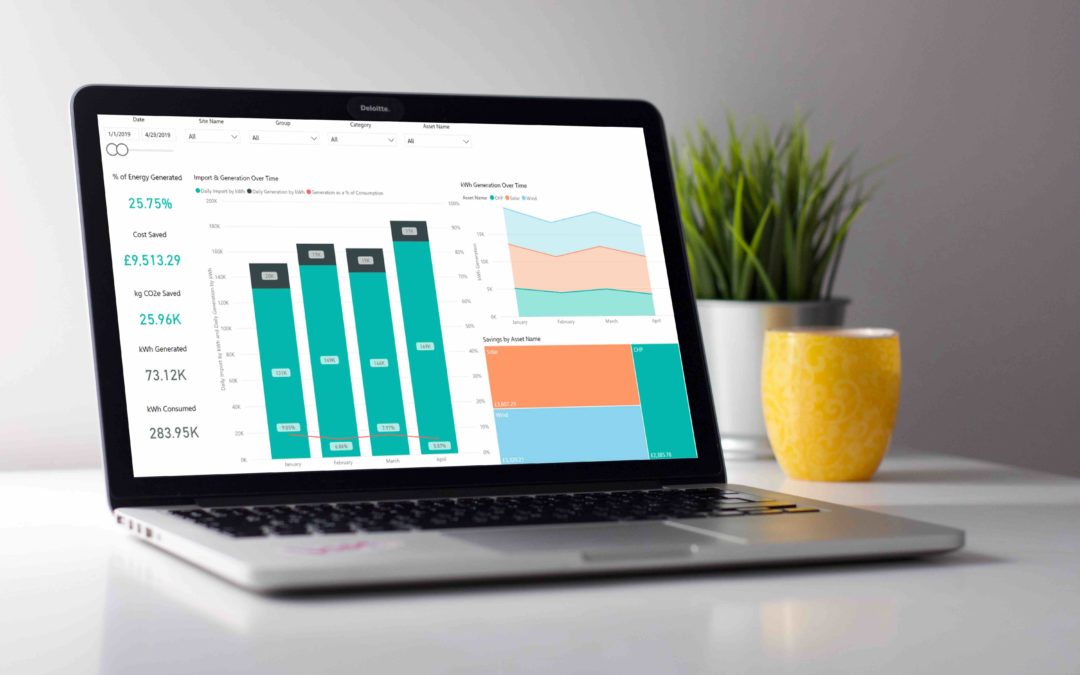Start the journey to a ‘sustain & save’ future with 3 steps to analyse your energy data. Read more in our recent article, written by CEO Richard Brys, in the Energy Management & Sustainability section of Tomorrows Facility Management. (Full article below).
When being sustainable now saves you money.
We’ve known for a long time that burning fossil fuels is not good for the planet. Historically it’s been a challenge to source sustainable power and reduce carbon, through the use of renewable generation, quite simply because it was more expensive than grid power. But now end customers can reduce their carbon footprint and save money which is good for everyone. In short, we have arrived in an era where a sustainable course of action is more cost effective than a non sustainable one. A very positive choice set.
The cost of renewable energy has reduced significantly in the last 2 years (from £50+ MWh, to approximately £40 MWh) and this trend is continuing, as renewable technology becomes more cost-effective year on year. If we can encourage end customers to look at how they can self-supply at least a percentage of their energy consumption either through behind the meter solar or wind or through Power Purchase Agreements directly, working collaboratively with their energy supplier, we can help drive a positive future for our planet and save our businesses money.
Deciding what renewable technologies to invest in, whether to invest in on-site generation, PPAs or both, and what sites to select in your energy estate, requires serious consideration. In this article, we look at some of the factors which customers need to consider alongside the data sets required to transform their estate.
You can choose between on-site renewables, or PPAs direct with generators.
Incorporating renewables into your portfolio, can be achieved in two ways. You can either opt for on-site generation, where you install assets (wind and solar) onsite. Alternatively, you can contract directly with renewable generators, through a contract structure known as a Power Purchase Agreement (PPA) via your energy supplier.
PPAs will offset the wholesale cost of your power, whereas on-site generation will deliver the full savings of the fully delivered power cost. PPAs will also require you to sleeveyour energy purchases through your energy retail contract, with your energy supplier.
And the good news is, energy suppliers are here to help.
The traditional utility model is fast evolving from a supplier that simply sells a customers’ kWhs at the lowest price, to an energy provider that offers a fully tailored energy solution, encompassing renewable assets and energy management as part of their offering.
As more corporates become interested in renewable technologies, only those suppliers who can collaborate through the provision of services will deliver value to end customers, and thus become the partner of choice. The good news is they exist, and so its just a matter of shopping around and making sure your energy supplier is set-up to be your renewable partner going forward.
You can start the journey, with some data analysis of your estates.
For customers, the starting point, may be as simple as contacting your energy supplier and enquiring about what type of renewable services they offer. As with any investment, it’s worth performing the analysis yourself, or in conjunction with your supplier so you have the facts and figures to hand, to help you make the decision around what is right for you: –
- Step 1 – The starting point for your analysis, will be a forecast of energy consumption on a site by site basis for the next 5-10 years. It may also be useful to categorize your sites and attributes e.g. are you on a long-term lease or is the site purchased office, data center, manufacturing, so that you can group sites together, to determine how their load shape may change over time. You’ll then need to factor in increases/decreases in site’s consumption and perhaps adding/decreasing the number of sites based on your company’s growth. As with any forecast, it’s unlikely you will get a truly accurate picture of what the future will look like. So rather than trying to develop a perfect forecast, it may be better to stress test potential forecast scenarios in order to determine the return on investment.
- Step 2 – Once you have your energy consumption patterns, you will then need to forecast your energy costs on a site by site basis. It is well worth at this point, calculating both the fully delivered cost (including all third-party charges) as well as the wholesale power costs, as this will help in the decision making around whether to use on-site generation, or renewable PPAs. Again, acquiring fully accurate data sets, should not necessarily be the end goal. Instead it is better to identify 2-3 possible scenarios and evaluate the range of outcomes using those scenarios.
- Step 3 – With the above two data sets collated, you are now in a position to overlay the renewable energy curves, to see how this will off-set your consumption. If you are opting for on-site generation, you will need to look at the site by site energy consumption and cost, however if you are looking at PPAs, you can simply look at your entire portfolio’s consumption. You can look to match renewable generation curves (Wind/Solar) to optimize which generation asset best fit the consumption of your estate.
Proactively managing your investments & PPAs.
Remember that the work doesn’t stop after the investment case is complete. Once you have elected to implement either a PPA structure, or on-site generation, you will want to continue to manage/monitor your assets, and ensure there is an understanding on how your strategy influences your energy bill and ESG policy and you achieve the benefits anticipated in your investment case.
Making sure you have access to the renewable data sets, or the generation data (if via a PPA) will be important too, when you are structuring your agreements. Having access to these data sets will allow you to manage and monitor your energy investments to ensure they meet your original goals. So, it’s well worth ensuring you have access at the time you structure your agreement.
Partnering together to increase renewable energy.
Utilidex has commenced incorporating renewable energy management ensuring we can start to provide the tools, for customers to answer these very important questions on their journey to a “sustain and save” future. And as we continue to work with forward thinking energy suppliers and customers alike, we’re glad and honoured to help play our part to shape a sustainable future.
Contact us today to find out how we can help you.
Applications to help you do more
You can purchase any one of our software products direct as a customer, or through our partner consultancy firms (TPIs), or via energy suppliers. Our goal is to make it easy for you to work together, and stay in control of your energy estate.






